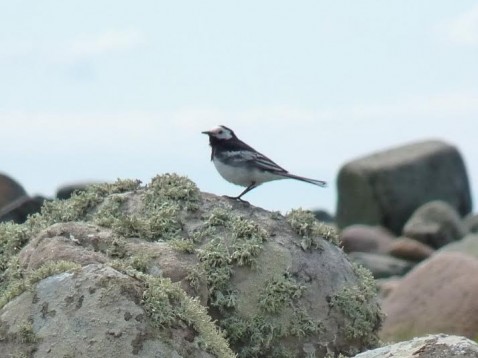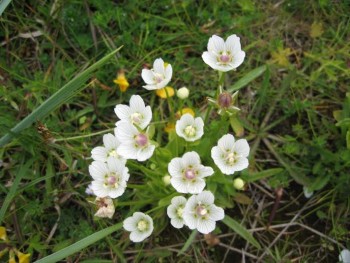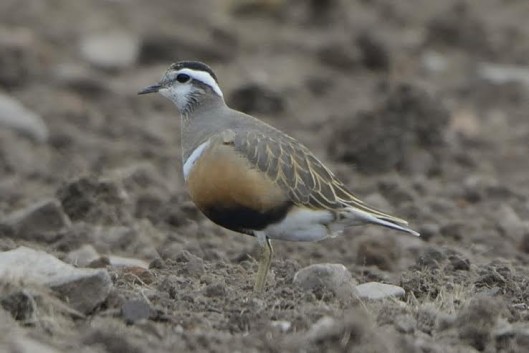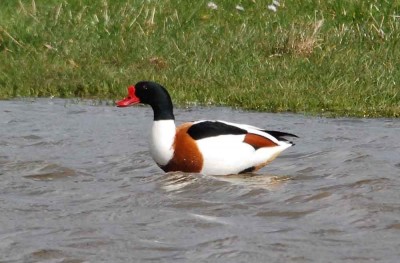Bird Report - August 2104
With the year on the wane the breeding season is just about over, although we still have young
House-sparrows, Greenfinches and Blackbirds begging for food from their parents. Also, I was
surprised to find part of a house-sparrow eggshell on August 21st which seems quite late. 2014 has
been a good breeding year for the birds as our mixed flock at Sunnybank can testify. A Wren in our
plantation gave added interest.
Easily seen just now are Pied Wagtails - adults and juveniles - which will be moving on for the winter.
(photo of Pied Wagtail by Pauline Wilson). On August 3rd at Newark Bay I watched an adult jump
in the air to catch insects to feed to its offspring. (Daisy Aitken reports there were a number of
this species at the Geo later in the month). Also on this day two Arctic Terns were diving in the sea
searching for sandeels. Four Hooded Crows were in Russell's field so I assumed these were a family
group.
August is the month when Jellyfish appear on our shores and I have seen a couple of the Common
Blue species at Newark - these sting so beware!
A feature of some of my recent walks have been Small Tortoiseshell Butterflies. I saw this brightly-
coloured species down the Gritley track then two at Newark. Another was flying amongst the
flowers down the peat road while, at the same time, a splendid pale grey Hen Harrier was hunting in
the fields.
On another walk I reached the bottom of the track that leads from opposite Hacco down to the
shore and was lucky to see a Short-eared Owl alight on a fencepost then was even luckier when
another appeared and landed not too far away. I wondered if one was a juvenile on an outing with
its parent.
On another walk at Newark on August 11th there were 4 Linnets tucking into the burdock in Russell's
field. Overhead flew a party of about 15 Terns - to me they looked a bit bigger than Arctics and could
have been Sandwich Terns but too far away for me to positively identify.
Migrating birds will be thinking of making a move soon. I have seen a Wheatear at Newark and there
were another two on the fence near Ashley Rosie's. Accompanying them were a handful of Meadow
Pipits and, of course, Pied Wagtails.
Swallows are noticeable just now. On a walk to Deerness Stores there were at least 20 flying around
the Eastersands area. Some will have raised 3 broods over the summer so won't be ready to leave
our shores just yet.
Keith Hague is seen regularly spotting birds around the parish and he recently reported some rarer
species: 4 Greenshanks and 4 Ruff at Braebuster Ness , a Stonechat at Halley and 51 Bar-tailed
Godwits at St. Peter's Pool.
With the year wearing on more migrants will be passing through Deerness so look extra carefully in
the bushes for any rarities!
PAULINE WILSON
Bird Report - July 2014
At the beginning of the month I stopped the car as I approached Seatter to look at two well-grown
Lapwing chicks in the field. Further along the road, near Ashley Rosie's, I encountered to a small
Oystercatcher chick in the road as a very worried parent was alarmed when my car approached. It
was a very slow driving pace as the panicking chick ran ahead before finally disappearing into the
hedge quickly followed by the adult bird.
I was lucky to have a second trip to the Holms of Copinsay with Sidney Foubister and it was fantastic
to see a colony of Arctic Terns with chicks. Sid pointed out the sandeels around our boat which is
really good news for the seabirds. There were lots of puffins, guillemots, razorbills, tysties and shags
in the water and the seals were posing nicely.
I did a beached birds survey at Newark Bay and spotted two Eider Ducklings being shepherded by
two 'aunties'. There was a juvenile Pied Wagtail on the beach and a single Ringed Plover which made
me wonder if there was a nest nearby. Two noisy Redshanks also accompanied my walk.
There is aptly-named Sweet Rocket flowering along the beach and, on the path back, wild flowers
were at their best - yellow ladies' bedstraw with its delicate leaves, purple vetch, kidney vetch,
yarrow in pink and white, cocks & hens, the sparse flowers of silverweed, ragwort, sow thistle.
Looking beyond the path into Russell's field, burdock was developing its sticky buds.
On a visit to Sandside Bay wild flowers were again the theme as lady's mantle lined the track, along
with mayweed, vetch and curly doddies. A meadow brown butterfly flitted among the flowers and
a Curlew gave its alarm call - obviously a chick not far away. Oystercatcher chicks were sure to have
been hiding also as the parent birds kept guard from atop a pile of dung!
Reaching the beach I saw 3 Arctic Terns diving for sandeels, another lone Ringed Plover and a least
100 Oystercatchers on the shore.
Once again wild flowers were centre stage and I was surprised and delighted to find Grass of
Parnassus in flower in the little meadow at Sandside
photo of Grass of Parnassus by Pauline Wilson
along with yellow and bright purple vetch, eyebright, rosa rugosa, clover, mayweed,
ragwort, yarrow. I also noted that Angelica is now in flower - a sign that the year is wearing on, but a
lovely time of year nevertheless.
Pauline Wilson
Bird Report - June 2014
There was a notable sighting in the parish in May - after I had written my report - so I thought it deserved a mention. In the ploughed field at the side of Braemar a small group of Dotterel were spotted and I was able to go along and get a very good view of these striking birds which are occasionally seen on migration through Orkney. These birds always seem to be in ploughed fields, probably as a form of camouflage. Unusually, it is the male bird who takes on responsibility for hatching the eggs.
Photo of Dotterel at Braemar by Ian Cunningham.
Of course, June is all about breeding in the bird world and we have lots of young Starlings, House Sparrows, Blackbirds and Greenfinches just now at Sunnybank.
On a walk down the trail from Hacco to the shore I noted a Meadow Pipit with food in its beak, obviously destined for hungry chicks.
The path down to Sandside is alive with the sounds of Skylarks so these fields must be a favourite nesting place for the breed. Meadow Pipits are common there also.
Just now plenty of Oystercatchers can be seen perched on fence posts, a sure sign that chicks won't be far away. The same goes for Curlews. Lapwings will also have young so listen out for their distinctive call.
Silage is being cut in the parish at present and the newly-cut fields are a magnet for birds such as Gulls, Hooded Crows, Starlings, Oystercatchers.
I was at Sandside Bay on June 14th and was delighted to see a pair of Shelducks with 6 ducklings. Usually you see one parent at either end of a brood to give extra protection from predators.
The following day, again at Sandside, there were Eider females and ducklings swimming along. There should be plenty of sightings of Eiders just now.
I had an enjoyable trip on June 15th with Sidney Foubister to see Puffins at the Holms of Copinsay - lovely to see these birds at close quarters and the nearby Seals were an added bonus.
In the field at the back of Daisy Aitken's house recently I spotted three Linnets - very handsome birds with red markings on the male.
I have just had a report of a breeding pair of Short-eared Owls at Mull Head so keep a look out for these when you next have a walk there.
Pauline Wilson
Birdlife in Deerness May 2014
By way of a postscript to my April report when I said no Hawfinches had visited this spring - just a few days later there was a female on the lawn. She stayed for just a brief while but it was lovely to see this bird.
Here at Sunnybank we have had a nice selection of birds. A Chiffchaff was flitting around in the back garden - this bird's call echoes its name, ie chiffchaff. Bramblings have brightened up the scene with their orange plumage; there was a female one day then 3 colourful males were around for a couple of days. I had a quick glance of a Blackcap in the bushes before it flew off. A Wheatear was in the field. One morning I was lucky to see a Linnet atop the bushes in our small plantation and I wondered if it was looking for a place to nest. I am pleased to report that we have a Blackbird sat on a nest in the byre.
I had a phone call from Donna Yule of Nethersands to say she had a Black Redstart on her windowsill meaning she had a fine view of this rare species.
As I rounded the corner close to St. Peter's Pool recently I spotted 2 Shelducks in a nearby pool
By way of a postscript to my April report when I said no Hawfinches had visited this spring - just a few days later there was a female on the lawn. She stayed for just a brief while but it was lovely to see this bird.
Here at Sunnybank we have had a nice selection of birds. A Chiffchaff was flitting around in the back garden - this bird's call echoes its name, ie chiffchaff. Bramblings have brightened up the scene with their orange plumage; there was a female one day then 3 colourful males were around for a couple of days. I had a quick glance of a Blackcap in the bushes before it flew off. A Wheatear was in the field. One morning I was lucky to see a Linnet atop the bushes in our small plantation and I wondered if it was looking for a place to nest. I am pleased to report that we have a Blackbird sat on a nest in the byre.
I had a phone call from Donna Yule of Nethersands to say she had a Black Redstart on her windowsill meaning she had a fine view of this rare species.
As I rounded the corner close to St. Peter's Pool recently I spotted 2 Shelducks in a nearby pool
(Photograph of Shelduck courtesy of Ian Cunningham)
Swallows are now very noticeable - there were a few at Eastersands on May 6th and they are now a common sight as they explore barns, old buildings, etc. for possible nesting sites. Swallows usually have two broods but can have three in a good year. While driving on the road to the Gloup on May 16th there were 4 on the fencing wire then there were several flying around at the Gloup.
Isobel Gardner phoned me one night to say there was a Corncrake calling nearby. I immediately went to hear it for myself and what to joy to listen to this bird as he seeks a mate after his long journey from Africa.
Doing a beached birds survey at Newark I spotted my first Bonxie of the season as it hunted along the coastline.
At the Gloup a Black Guillemot (Tystie) was making itself comfortable on a ledge, while nearby a pair of Pied Wagtails appeared to have selected a crevice as a nesting site.
As you walk by the fields in the parish there are lots of species to be seen - Meadow Pipits, Skylarks calling, Lapwings swooping and making their unmistakable sound, Oystercatchers, Curlews - all intent on making, then defending, their nests.
There's certainly plenty to see in Deerness just now






